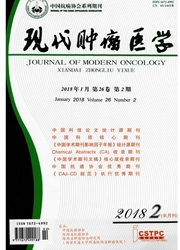

 中文摘要:
中文摘要:
目的:探讨ANO1蛋白在食管鳞状细胞癌组织中表达的瘤内异质性及与肿瘤临床病理学特征的关系。方法:采用组织微阵列免疫组化法检测122例食管鳞癌每例4个肿瘤取材区域及相应正常组织中ANO1蛋白的表达情况,比较每例肿瘤不同取材区域的表达差异,分析ANO1蛋白表达情况与患者临床病理学特征的相关性。结果:ANO1蛋白在所有正常组织中呈阴性表达,而在肿瘤组织的表达阳性率为53.3%(65/122)。统计学分析显示,ANO1蛋白的表达情况在有、无淋巴结转移之间及不同肿瘤临床分期之间存在显著性差异(P〈0.05)。在阳性表达的病例中,绝大多数(55/65)肿瘤内显示不同程度的ANO1蛋白表达异质性,其中32.3%(21/65)的病例存在不同取材区域之间较大的异质性。结论:ANO1蛋白在正常组织中呈阴性表达,在食管鳞状细胞癌组织中呈部分阳性表达,与临床病理学参数存在显著相关性(P〈0.05)。而且,食管鳞状细胞癌ANO1蛋白表达存在明显的瘤内异质性,多位点取材有助于提高ANO1表达的检出率并可减少漏检。
 英文摘要:
英文摘要:
Objective: To investigate the intratumoral heterogeneity of ANO1 protein expression in esophageal squamous cell carcinoma( ESCC), and to analyze the correlation between the expression of ANO1 protein and the clin- icopathologic features in ESCC. Methods:The expressions of ANO1 protein in four regions for each tumor and the cor- responding operative margin were detected by tissue microarray immunohistochemistry in 122 paired samples. The ANO1 expression differences between different sampling regions in every single tumor and the relationship between the expression of ANO1 protein and the clinicopathological features of the patients were analyzed. Results: ANO1 protein showed negative expression in all the corresponding operative margin tissues, while the 53.3% (65/122) of tumors presented positive ANO1 expression. Statistical analysis results indicated that the expression of ANO1 protein was sig- nificantly different in the patients with and without lymph node metastasis and among different tumor clinical stages (P 〈 0.05). In the positive cases, ANO1 expression showed different degree of heterogeneity in the vast majority (55/ 65 ) of the tumors,in which 32.3% (21/65) of the cases had greater difference in ANO1 protein level among four dif- ferent sampling regions for each. Conclusion :The expression of ANO1 protein was negative in normal tissues and par- tially positive in the ESCC tumor tissues, having significant correlation with clinical pathological parameters. More im- portantly,there exists intratumoral heterogeneity in the expression of ANO1 protein in ESCC. Sampling in multiple sites will help improve the detection and reduce the missing rate of ANO1 protein expression.
 同期刊论文项目
同期刊论文项目
 同项目期刊论文
同项目期刊论文
 期刊信息
期刊信息
